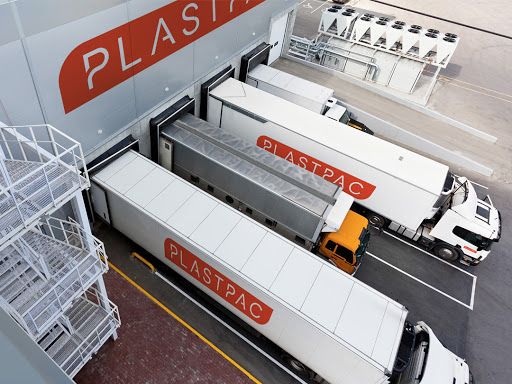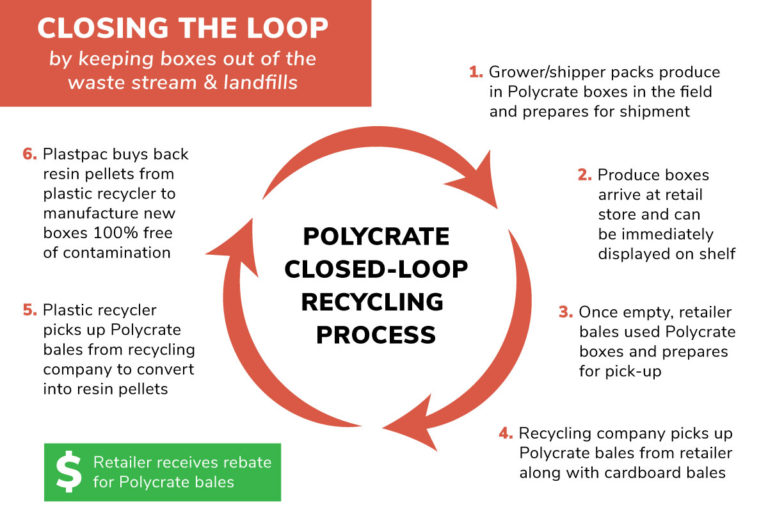The Future of Recycling
Plastpac has developed a Closed-Loop Recycling program that enables our Polycrates™ boxes to be picked up from a depot — bailed in full loads. The boxes are then cleaned and recycled — ready for re-use in the supply chain.
PRODUCE BLUE BOOK OVERVIEW
In a closed-loop recycling system, packaging is designed with the goal that all of the material can be recycled into the same type of product after it reaches the end user. This yields less waste than an open-loop system where only some components of the packaging are reused and those that are used suffer degradation in the recycling process. Supply chain sustainability is the main focus of closed-loop recycling.
According to the U.S. Environmental Protection Agency (EPA), plastic recycling results in significant energy savings compared with production of new plastics using virgin material. In fact, recycling plastic takes 88 percent less energy than making plastic from raw materials.
Closed-loop systems are not new, however, they have not been as effective as open-loop recycling. This is a result of little demand for post-consumer recycling programs and a lack of consumer education about the recycling process. Historically, consumers have been taught to throw all packaging into one bin for recycling. However, different plastics have different chemical compositions and cannot be recycled together.
For example, PET or polyethylene terephthalate bottles cannot be mixed with polypropylene to create a viable product, since they have each very different melt flows. Some packaging companies are taking notice and focusing their efforts on improving the closed-loop recycling system in their packaging designs.
Supply chain sustainability is the main focus of closed-loop recycling.
Value of closed-loop system for packaging
- Minimizes risk of harm to the environment and wildlife
- Saves space in landfill for waste that has no recycling option
- Reduces the need to harvest raw materials – preserving the rainforest and other planet natural resources

Frequently Asked Questions about Closed-Loop Packaging
Can Polycrate plastic corrugated boxes and cardboard be baled together?
No, these packaging products should be baled separately
Can Polycrate boxes be picked up by the recycling company along with the cardboard bales?
Yes, as long as it is coordinated with the companies in advance
Can Polycrate boxes be put into the same baler as the cardboard? Can it be baled using the same baling wire?
Yes, the baling process is the same as cardboard
Can Polycrate boxes be picked up without baling?
Yes they can be piled into the trailer on pallets with shrink wrap
Will retailers and wholesalers receive a rebate for baling and shipping Polycrate plastic corrugated boxes?
Yes, but this will depend on the recycling companies
How does Plastpac receive the ‘used’ plastic corrugated boxes?
Plastpac will coordinate delivery with the recycling companies. Plastpac will give the rebate to the recycling companies who in turn, give it to the retailers or wholesalers.
Does the recycling company re-process and recycle the used plastic packaging into post-consumer resin? Or is that Plastpac?
Plastpac manages the recycling of the product.
How does the Polycrate packaging get picked up from the retailer?
We recommend that the plastic packaging is returned to the warehouse or distribution center after every delivery so that the recycling company can pick up the aggregated bales from the warehouse rather than the individual stores.
What are the advantages for a retailer to recommend and use Plastpac plastic corrugate boxes in their Produce section?
Polycrate boxes are lighter weight, yet more durable and water resistant than cardboard or wax boxes. This allows the Produce to stay fresher longer while traveling from the field — through the food supply chain. And because of its strength and stability, these food-safe boxes can move from farm to the Produce cooler.
Retailers can also take advantage of the planet-friendly packaging that is made from recycled materials — and can be recycled again after use


